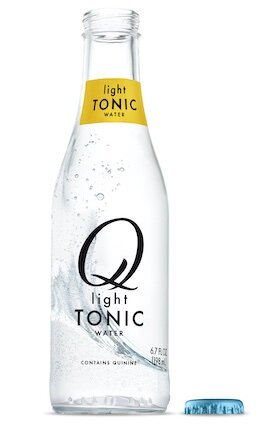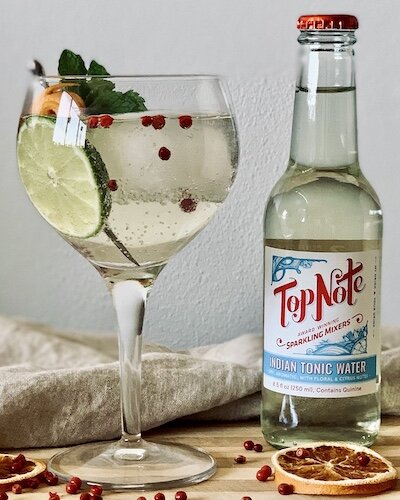What Makes a Great Tonic Water and Why it Matters
Full range of Fever-Tree tonics
A tonic water is a tonic water, except, really, it’s not. Gone are the days when practically every tonic water on the market was made with high fructose corn syrup and tasted like Sprite with a dash of quinine. Instead, craft tonic makers are creating a diverse and aromatic array of styles and flavored tonic waters as well as tonic adjacent mixers.
“We started with the tonic because this is what the consumer was really missing on, and then we (moved into) the ginger ale, and then we start thinking about the opportunity to elevate a cocktail, and that’s where it always starts,” says Tim Warrilow, co-founder of Fever-Tree. In fact, according to a 2020 tonic water trends and market analysis from Grand View Research, the global tonic water market size was valued at $1.72 billion (USD), and it’s expected to grow at a compound annual growth rate of 7.2 percent through 2027.
“The first rule I have (for tonic waters and spirits) is to have fun,” says Jordan Silbert, founder of Q Mixers. “There aren’t any hard and fast rules. Just because one tonic is intended to do one thing doesn’t mean it shouldn’t be used for others. You should do what tastes right.” While just about every tonic water on the market – from classic to Indian to elderberry – goes with gins and vodkas, tequilas, rums, whiskeys and even aperitivos and fine coffees can play well with them. “I’ve seen some creative coffee roasters make some wonderful drinks with our Indian tonic,” says Mary Pellettieri, founder of Top Note Tonic.
“It’s a phenomenal time to be a drinker,” Silbert says. “There are all of these amazing craft distilleries all making these very interesting gins, and when you taste the difference between a good spirit and a good mixer with a good spirit and a bad mixer, it’s night and day. One is delightful. The other is like, eh.”
Here’s an overview of some tonics that are anything but eh.
Classic Tonic Waters
Whether made by Fever-Tree, Fentimans, Q Tonic or Top Note, classic tonic waters are made to pair with classic, juniper-forward gins and vodkas. “Most classic tonic waters have that quinine bitterness, a lemon-lime top note, with an actual middle level of sweetness,” Pelletieri says.
Light Tonic Waters
Q light tonic water
Q, Fentiman’s and Fever-tree each make tonic waters with reduced calories, but offer the same profile of a regular classic tonic. Sometimes classified as “diet,” these tonic waters aren’t the diet soda equivalents, as they usually combine different sweeteners, but their calorie counts come in to less than half or a third of regular tonic waters, and they usually pair well with both gins and vodkas. And most craft tonics have a lot less sugar and calories than mass-produced tonics. “Our Spectacular tonic is 40 calories per bottle, and our light one has 20 calories per bottle,” Silbert says. This sector of tonic waters is “anticipated to be the fastest growing segment,” according to the Grand View Research analysis. “We know that low calorie is on trend in the marketplace,” Warrilow says. “Over one-third of all Fever-Tree sold is low calorie, but low calorie should never come at the expense of taste.”
Indian Tonic Waters
Classic Spanish G&T photo credit Steph Achter Top Note Tonics
The name Indian tonic references the time when quinine was used to prevent malaria in India. Some Indian tonics have a more intense quinine flavor, that pairs really well with gins, vodkas and even fortified wines like port and sherry. Pellettieri says her Top Note Indian tonic is quite different.
“A traditional Indian tonic is just a super strong tonic,” she says, adding that the main bittering agent remains quinine. “For us, we use both gentian root and classic bitters found in aperitivos, as well as quinine, and to me, it has a grapefruit top note, a hoppy element like an IPA so I called it Indian tonic water,” says Pellettieri, who worked for Goose Island and Miller/Coors before starting her tonic company. “In my mind, I think more like a brewer. Top Note Indian tonic, she says, goes really well with subtle and higher end gins that are more delicate rather than a London dry style, which most Indian tonics pair well with. “Indian Top Note is going to amplify the floral notes and not overwhelm those gins,” she says. “This tonic is really meant for finer gin drinkers who want a better experience. But it’s not a vodka tonic kind of tonic, as it almost comes off as sweet. It’s not really sweet, but the vodka doesn’t do much for it, and it kind of dilutes some of the flavors and muddies it up.”
She says her Indian tonic also goes really, really well in espresso and coffee drinks. “Something about the Indian tonic mixes so much better than a regular tonic,” she says. “It has a flavor like a chocolate covered citrus peel when it’s paired with the right coffee. It’s light and has this honeysuckle note.”
Specialty Tonics
Specialty tonics include flavored or aromatic tonics, and this category includes everything from cucumber and lemon to elderberry, and each craft tonic company has its own specialty tonics. Fever-Tree has six different tonics in this category, along with a couple of light versions, as well as some tonic adjacent mixers.
“How much time do we have to discuss this?” says Charles Gibb, CEO of Fever Tree North America. “I just really encourage people to experiment and enjoy playing with them.” For example, Fever-Tree’s Aromatic tonic goes really well with gin, but “an Aromatic tonic with whiskey is absolutely delicious,” Gibb says. Also, he notes that the Fever-Tree Cucumber tonic and Refreshingly Light Cucumber tonic do pair with a herbal gins, but it also pairs “amazingly well” with Aperol.” “It creates this amazing, low calorie, low alcohol spritz drink, which is fantastic,” Gibb says.
Another really interesting specialty tonic is Elderflower. Silbert says his sister’s life partner made an elderflower syrup, which he added to their gin and tonics. “It was like a garden party on a Saturday night,” Silbert says, adding that inspired him to create a Q Elderflower tonic. Q Elderflower tonic goes really well with gins that have strong citrus notes, but it also balances out more juniper-forward gins. “The first rule I have is to have fun,” he says. “There are not any hard and fast rules, and just because a tonic is intended to do one thing doesn’t mean it shouldn’t be done with another spirit.”
Pellettieri’s third tonic is a Bitter Lemon tonic. Like her Indian tonic, it has gentian root and quinine as the bitter backbone, but it also has a lot of lemon juice in it, not just lemon essence or lemon flavoring. “There’s a little more sweetness,” she says. “You can drink it as an aperitivo soft drink on its own, but it pairs really well with a London Dry, and a lot of bartenders mix it with a variety of liqueurs and spirits.”




